Scythian Kurgans & Monuments of west & east Eurasia, 2000 - 100 BCE.
Geel et al. (2004)
Geel et al. (2004)
“The Scythians buried their dead and marked their tombs with burial mounds. There are tens of thousands of these mounds scattered across the vast steppe region which stretches from northern China through southern Siberia to the northern Black Sea. They are often clustered in groups or lines, and these likely represent tribal or family cemeteries. Some are small, others are very large, and where they are intact the grave goods show that the larger the burial mound, the higher the status of the deceased.”
British Museum Exhibition, 2017.
British Museum Exhibition, 2017.
I am the ritual and the sacrifice;
I am true medicine and the mantram.
I am the offering and the fire which consumes it,
and the one to whom it is offered.
I am the father and mother of this universe;
And its grandfather too; I am its entire support.
I am the sum of all knowledge, the purifier, the symbol Om;
I am the sacred scriptures the Ṛg, Sāma and Yajur Vedas.
Bhagavad Gita 9:16-17.
#Vedic #Hinduism
I am true medicine and the mantram.
I am the offering and the fire which consumes it,
and the one to whom it is offered.
I am the father and mother of this universe;
And its grandfather too; I am its entire support.
I am the sum of all knowledge, the purifier, the symbol Om;
I am the sacred scriptures the Ṛg, Sāma and Yajur Vedas.
Bhagavad Gita 9:16-17.
#Vedic #Hinduism
Forwarded from Himā-laya (Lakhey)
Media is too big
VIEW IN TELEGRAM
Himalayan tribes performing shamanic dance.
The Kurds speak the Kurdish language (Kurdî, کوردی), which has c. 20 - 30 million native speakers, mostly in Turkey & Syria.
Many Kurds believe they are descended from the Ancient Medes, an Iranic group who built an empire in the region (c. 6th century BCE). Today, the dominant religion of the Kurds is Sunni Islam, but sizeable minorities practise native faiths such as Yazidism and Zoroastrianism, alongside Kurdish adherents to Shia Islam, Christianity and Judaism, and the syncretic religion of Yarsanism.
The #Mitanni Kingdom (1500 - 1350 BCE) was a Hurrian-speaking realm ruled by a Royal caste of Old-Indic speakers. The kings, from first to last, took Indo-Aryan names, such as Ṛtadhaaman ('abode of Ṛta'), Tvesaratha ('an attacking chariot') and Ṛtasmara ('remembering Ṛta'). That many of them contained the Ṛgveda's central moral concept, Ṛta (Cosmic Order), demonstrates the antiquity of the religious practises of the Indo-Aryan peoples.
In a 1380 BCE treaty with another Indo-European people, the Hittites, the Mitanni King Kurtziwaza named four Vedic deities, Indra, Varuṇa, Mitrá and the Aśvin, as witnesses.
In a 1380 BCE treaty with another Indo-European people, the Hittites, the Mitanni King Kurtziwaza named four Vedic deities, Indra, Varuṇa, Mitrá and the Aśvin, as witnesses.
"...the Mitanni kingdom was founded by Old-Indic-speaking mercenaries, perhaps charioteers, who regularly recited the hymns and prayers that were collected at about the same time far to the east by the compilers of the Rig Veda. Hired by a Hurrian king about 1500 BCE, they usurped his throne and founded a dynasty, a very common pattern in near-eastern and Iranian dyanstic histories. The dynasty quickly became Hurrian in almost every sense but clung to a tradition of Old-Indic royal names, some Vedic deity names, and Old-Indic technical terms related to chariotry long after its founders faded into history."
Prof. David Anthony, The Horse, The Wheel and Language (2007), p 50
Prof. David Anthony, The Horse, The Wheel and Language (2007), p 50
Ceramic #Swastika vessel (Scythian).
Khanlar, Azerbaijan, 11th century BCE.
Khanlar, Azerbaijan, 11th century BCE.
Tibetan Buddhist #Swastika (Svastika) Art.
(Shechen Archive)
(Shechen Archive)
